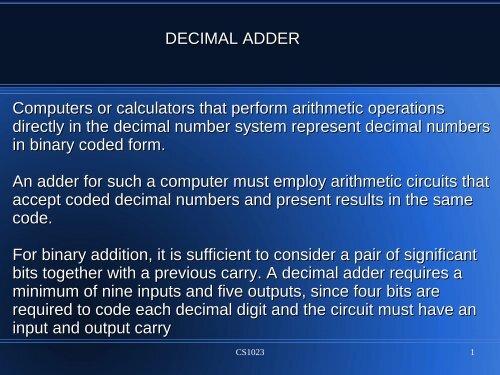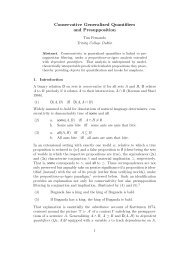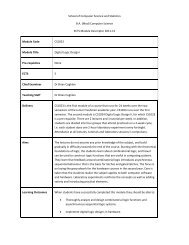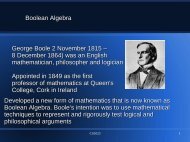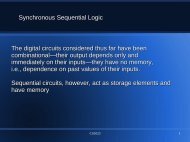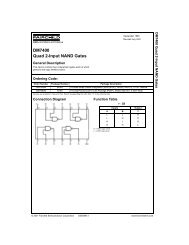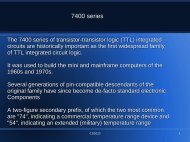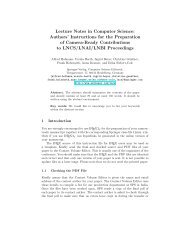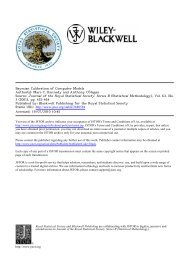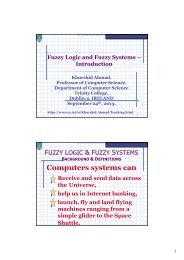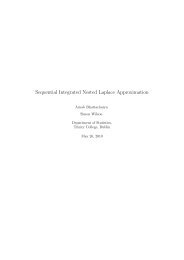DECIMAL ADDER Computers or calculators that perform arithmetic ...
DECIMAL ADDER Computers or calculators that perform arithmetic ...
DECIMAL ADDER Computers or calculators that perform arithmetic ...
You also want an ePaper? Increase the reach of your titles
YUMPU automatically turns print PDFs into web optimized ePapers that Google loves.
<strong>DECIMAL</strong> <strong>ADDER</strong><br />
<strong>Computers</strong> <strong>or</strong> calculat<strong>or</strong>s <strong>that</strong> perf<strong>or</strong>m <strong>arithmetic</strong> operations<br />
directly in the decimal number system represent decimal numbers<br />
in binary coded f<strong>or</strong>m.<br />
An adder f<strong>or</strong> such a computer must employ <strong>arithmetic</strong> circuits <strong>that</strong><br />
accept coded decimal numbers and present results in the same<br />
code.<br />
F<strong>or</strong> binary addition, it is sufficient to consider a pair of significant<br />
bits together with a previous carry. A decimal adder requires a<br />
minimum of nine inputs and five outputs, since four bits are<br />
required to code each decimal digit and the circuit must have an<br />
input and output carry<br />
CS1023 1
Since each input digit does not exceed 9, the output sum cannot be<br />
greater than 9 + 9 + 1 = 19, the 1 in the sum being an input carry.<br />
Suppose we apply two BCD digits to a four-bit binary adder. The<br />
adder will f<strong>or</strong>m the sum in binary and produce a result <strong>that</strong> ranges<br />
from 0 through 19.<br />
These binary numbers are labeled by symbols K, Z8, Z4, Z2, and<br />
Z1. K is the carry, and the subscripts under the letter Z represent<br />
the weights 8, 4, 2, and 1 <strong>that</strong> can be assigned to the four bits in<br />
the BCD code<br />
CS1023 2
Derivation of BCD Adder<br />
CS1023 3
When the binary sum is equal to <strong>or</strong> less than 1001, the<br />
c<strong>or</strong>responding BCD number is identical, and theref<strong>or</strong>e<br />
no conversion is needed.<br />
When the binary sum is greater than 1001, we obtain an invalid<br />
BCD representation.<br />
The addition of binary 6 (0110) to the binary sum converts it to<br />
the c<strong>or</strong>rect BCD representation and also produces an output carry<br />
as required<br />
CS1023 4
The logic circuit <strong>that</strong> detects the necessary c<strong>or</strong>rection can be<br />
derived from the entries in the table.<br />
It is obvious <strong>that</strong> a c<strong>or</strong>rection is needed when the binary sum has<br />
an output carry K = 1.<br />
The other six combinations from 1010 through 1111 <strong>that</strong> need<br />
a c<strong>or</strong>rection have a 1 in position Z8.<br />
To distinguish them from binary 1000 and 1001, which also have<br />
a 1 in position Z8, we specify further <strong>that</strong> either Z4 <strong>or</strong> Z2 must<br />
Have a 1.<br />
CS1023 5
The condition f<strong>or</strong> a c<strong>or</strong>rection and an output carry can be<br />
expressed by the Boolean function<br />
C = K + Z8.Z4 + Z8.Z2<br />
When C = 1, it is necessary to add 0110 to the binary sum and<br />
provide an output carry f<strong>or</strong> the next stage<br />
CS1023 6
Block diagram of a BCD adder<br />
CS1023 7
B I N A RY<br />
M U LT I P L I E R<br />
Multiplication of binary numbers can be perf<strong>or</strong>med in the same<br />
way as multiplication of decimal numbers.<br />
The multiplicand is multiplied by each bit of the multiplier, starting<br />
from the least significant bit.<br />
Each such multiplication f<strong>or</strong>ms a partial product. Successive<br />
partial products are shifted one position to the left.<br />
The final product is obtained from the sum of the partial products<br />
CS1023 8
The first partial product is f<strong>or</strong>med by multiplying B1 B0 by A0.<br />
The multiplication of two bits such as A0 and B0 produces a 1 if<br />
both bits are 1; otherwise, it produces a 0.<br />
This is identical to an AND operation. Theref<strong>or</strong>e, the partial<br />
product can be implemented with AND gates as shown in the<br />
diagram.<br />
The second partial product is f<strong>or</strong>med by multiplying B1 B0 by A1<br />
and shifting one position to the left.<br />
CS1023 9
Two-bit by two-bit binary multiplier<br />
CS1023 10
The two partial products are added with two half-adder (HA)<br />
circuits.<br />
Usually, there are m<strong>or</strong>e bits in the partial products and it is<br />
necessary to use full adders to produce the sum of the partial<br />
products.<br />
CS1023 11
A combinational circuit binary multiplier with m<strong>or</strong>e bits can be<br />
constructed in a similar fashion.<br />
A bit of the multiplier is ANDed with each bit of the multiplicand in<br />
As many levels as there are bits in the multiplier.<br />
The binary output in each level of AND gates is added with the<br />
partial product of the previous level to f<strong>or</strong>m a new partial product.<br />
The last level produces the product. F<strong>or</strong> J multiplier bits and K<br />
multiplicand bits, we need J * K AND gates and J - 1 K-bit<br />
adders to produce a product of (J + K) bits.<br />
CS1023 12
Four-bit by three-bit binary multiplier<br />
CS1023 13
Consider a multiplier circuit <strong>that</strong> multiplies a binary number<br />
represented by four bits by a number represented by three bits.<br />
Let the multiplicand be represented by B3 B2 B1 B0 and the<br />
multiplier by A2 A1 A0.<br />
Since K = 4 and J = 3, we need 12 AND gates and two 4-bit<br />
adders to produce a product of seven bits.<br />
CS1023 14
Magnitude Comparat<strong>or</strong><br />
The comparison of two numbers is an operation <strong>that</strong> determines<br />
whether one number is greater than, less than, <strong>or</strong> equal to the<br />
other number.<br />
A magnitude comparat<strong>or</strong> is a combinational circuit <strong>that</strong> compares<br />
two numbers A and B and determines their relative magnitudes.<br />
The outcome of the comparison is specified by three binary<br />
variables <strong>that</strong> indicate whether A > B, A = B, <strong>or</strong> A < B.<br />
CS1023 15
The circuit f<strong>or</strong> comparing two n-bit numbers has 2^(2n) entries in<br />
the truth table and becomes too cumbersome, even with n = 3<br />
A comparat<strong>or</strong> circuit possesses a certain amount of regularity.<br />
Digital functions <strong>that</strong> possess an inherent well-defined regularity<br />
can usually be designed by means of an alg<strong>or</strong>ithm—a procedure<br />
which specifies a finite set of steps <strong>that</strong>, if followed, give the<br />
solution to a problem<br />
CS1023 16
The two numbers are equal if all pairs of significant digits are<br />
equal:<br />
When the numbers are binary, the digits are either 1 <strong>or</strong> 0, and<br />
the equality of each pair of bits can be expressed logically with<br />
an exclusive-NOR function as<br />
CS1023 17
To determine whether A is greater <strong>or</strong> less than B, we inspect the<br />
relative magnitudes of pairs of significant digits, starting from the<br />
most significant position.<br />
If the two digits of a pair are equal, we compare the next lower<br />
significant pair of digits.<br />
The comparison continues until a pair of unequal digits is reached<br />
CS1023 18
Four-bit magnitude comparat<strong>or</strong><br />
CS1023 19
DECODERS<br />
A binary code of n bits is capable of representing up to 2^n<br />
distinct elements of coded inf<strong>or</strong>mation.<br />
A decoder is a combinational circuit <strong>that</strong> converts binary<br />
inf<strong>or</strong>mation from n input lines to a maximum of 2^n unique<br />
output lines.<br />
If the n-bit coded inf<strong>or</strong>mation has unused combinations, the<br />
decoder may have fewer than 2^n outputs.<br />
CS1023 20
Three-to-eight-line decoder<br />
The decoder is a<br />
commonly used type of<br />
integrated circuit.<br />
This decoder generates all of<br />
the minterms of the three input<br />
variables.<br />
Exactly one of the output lines<br />
will be 1 f<strong>or</strong> each combination<br />
of the values of the input<br />
variables.<br />
CS1023 21
The prefix SN indicates <strong>that</strong><br />
the chip was made by Texas<br />
Instruments<br />
Low-power Schottky TTL (LS) –<br />
used the higher resistance values<br />
of low-power TTL and the Schottky<br />
diodes to provide a good<br />
combination of speed (9.5ns) and<br />
reduced power consumption<br />
(2 mW).<br />
CS1023 22
Truth Table of a Three-to-Eight-Line Decoder<br />
F<strong>or</strong> each possible input combination, there are seven outputs <strong>that</strong><br />
are equal to 0 and only one <strong>that</strong> is equal to 1. The output whose<br />
value is equal to 1 represents the minterm equivalent of the binary<br />
number currently available in the input lines<br />
CS1023 23
The term decoder is sometimes also used in conjunction with<br />
other code converters, such as a BCD-to-seven-segment decoder<br />
CS1023 24
CS1023 25
Two-to-four-line decoder with enable input<br />
Some decoders are constructed<br />
with NAND gates. Since a NAND<br />
gate produces the AND operation<br />
with an inverted output, it<br />
becomes m<strong>or</strong>e economical to<br />
generate the decoder minterms in<br />
their complemented f<strong>or</strong>m.<br />
Furtherm<strong>or</strong>e, decoders include<br />
one <strong>or</strong> m<strong>or</strong>e enable inputs to<br />
control the circuit operation<br />
CS1023 26
A decoder with enable input can function as a demultiplexer—a<br />
circuit <strong>that</strong> receives inf<strong>or</strong>mation from a single line and directs it to<br />
one of 2^n possible output lines.<br />
The selection of a specific output is controlled by the bit<br />
combination of n selection lines<br />
CS1023 27
The decoder above can function as a one-to-four-line demultiplexer<br />
when E is taken as a data input line and A and B are taken as the<br />
selection inputs.<br />
The single input variable E has a path to all four outputs, but the<br />
input inf<strong>or</strong>mation is directed to only one of the output lines, as<br />
specified by the binary combination of the two selection<br />
lines A and B.<br />
This feature can be verified from the truth table of the circuit. F<strong>or</strong><br />
example, if the selection lines A B = 1 0, output D2 will be the same<br />
as the input value E, while all other outputs are maintained at 1.<br />
Because decoder and demultiplexer operations are obtained from<br />
the same circuit, a decoder with an enable input is referred to as a<br />
decoder–demultiplexer<br />
CS1023 28
4 * 16 decoder constructed with two 3 * 8 decoders<br />
Decoders with enable inputs can be<br />
connected together to f<strong>or</strong>m a larger<br />
Decoder circuit. This shows two<br />
3-to-8-line decoders with enable inputs<br />
connected to f<strong>or</strong>m a 4-to-16-line<br />
decoder. When w = 0, the top<br />
decoder is enabled and the other is<br />
Disabled. The bottom decoder<br />
outputs are all 0’s, and the top eight<br />
outputs generate minterms<br />
0000 to 0111. When w = 1, the<br />
enable conditions are reversed:<br />
The bottom decoder outputs generate minterms 1000 to 1111, while the outputs of<br />
the top decoder are all 0’s.<br />
CS1023 29
In general, enable inputs are a convenient feature f<strong>or</strong><br />
interconnecting two <strong>or</strong> m<strong>or</strong>e standard components f<strong>or</strong> the<br />
purpose of combining them into a similar function with m<strong>or</strong>e<br />
inputs and outputs.<br />
CS1023 30
A decoder provides the 2^n minterms of n input variables.<br />
Each asserted output of the decoder is associated with a unique<br />
pattern of input bits.<br />
Since any Boolean function can be expressed in sum-of-minterms<br />
f<strong>or</strong>m, a decoder <strong>that</strong> generates the minterms of the function,<br />
together with an external OR gate <strong>that</strong> f<strong>or</strong>ms their logical sum,<br />
Provides a hardware implementation of the function.<br />
In this way, any combinational circuit with n inputs and m outputs<br />
can be implemented with an n-to-2^n-line decoder and m OR<br />
gates.<br />
CS1023 31
Implementation of a full adder with a decoder<br />
A function with a long list of minterms requires an OR gate with a large number of<br />
inputs. A function having a list of k minterms can be expressed in its complemented<br />
F<strong>or</strong>m F' with 2^n - k minterms. If the number of minterms in the function is greater than<br />
2^n/2, then F' can be expressed with fewer minterms (use NOR gate).<br />
CS1023 32
If NAND gates are used f<strong>or</strong> the decoder, as in then the<br />
external gates must be NAND gates instead of OR gates.<br />
This is because a two-level NAND gate circuit implements<br />
a sum-of-minterms function and is equivalent to a two-level<br />
AND–OR circuit<br />
CS1023 33
ENCODERS<br />
An encoder is a digital circuit <strong>that</strong> perf<strong>or</strong>ms the inverse operation<br />
of a decoder.<br />
An encoder has 2^n (<strong>or</strong> fewer) input lines and n output lines.<br />
The output lines, as an aggregate, generate the binary code<br />
c<strong>or</strong>responding to the input value.<br />
An example of an encoder is the octal-to-binary encoder whose<br />
truth table is given.<br />
CS1023 34
Truth Table of an Octal-to-Binary Encoder<br />
CS1023 35
The encoder can be implemented with OR gates whose inputs<br />
are determined directly from the truth table.<br />
Output z is equal to 1 when the input octal digit is 1, 3, 5, <strong>or</strong> 7.<br />
Output y is 1 f<strong>or</strong> octal digits 2, 3, 6, <strong>or</strong> 7, and output x is 1 f<strong>or</strong><br />
digits 4, 5, 6, <strong>or</strong> 7.<br />
These conditions can be expressed by the following Boolean<br />
output functions:<br />
z = D1 + D3 + D5 + D7<br />
y = D2 + D3 + D6 + D7<br />
x = D4 + D5 + D6 + D7<br />
CS1023 36
The encoder has the limitation <strong>that</strong> only one input can be active<br />
at any given time.<br />
If two inputs are active simultaneously, the output produces an<br />
undefined combination.<br />
F<strong>or</strong> example, if D3 and D6 are 1 simultaneously, the output of the<br />
encoder will be 111 because all three outputs are equal to 1.<br />
The output 111 does not represent either binary 3 <strong>or</strong> binary 6.<br />
CS1023 37
To resolve this ambiguity, encoder circuits must establish an input<br />
pri<strong>or</strong>ity to ensure <strong>that</strong> only one input is encoded.<br />
If we establish a higher pri<strong>or</strong>ity f<strong>or</strong> inputs with higher subscript<br />
numbers, and if both D3 and D6 are 1 at the same time, the output<br />
will be 110 because D6 has higher pri<strong>or</strong>ity than D3<br />
Another ambiguity in the octal-to-binary encoder is <strong>that</strong> an output<br />
with all 0’s is generated when all the inputs are 0; but this output is<br />
the same as when D0 is equal to 1.<br />
The discrepancy can be resolved by providing one m<strong>or</strong>e output to<br />
indicate whether at least one input is equal to 1<br />
CS1023 38
Pri<strong>or</strong>ity Encoder<br />
A pri<strong>or</strong>ity encoder is an encoder circuit <strong>that</strong> includes the pri<strong>or</strong>ity<br />
function.<br />
The operation of the pri<strong>or</strong>ity encoder is such <strong>that</strong> if two <strong>or</strong> m<strong>or</strong>e<br />
inputs are equal to 1 at the same time, the input having the<br />
highest pri<strong>or</strong>ity will take precedence.<br />
They are often used to control interrupt requests by acting on the<br />
highest pri<strong>or</strong>ity request.<br />
The truth table of a four-input pri<strong>or</strong>ity encoder is given<br />
CS1023 39
In addition to the two outputs x and y,<br />
the circuit has a third output designated<br />
by V; this is a valid bit indicat<strong>or</strong> <strong>that</strong> is<br />
set to 1 when one <strong>or</strong> m<strong>or</strong>e inputs are<br />
equal to 1. If all inputs are 0, there is no<br />
valid input and V is equal to 0.<br />
The other two outputs are not inspected<br />
when V equals 0 and are specified as don’t-care conditions. Note <strong>that</strong> whereas X’s in<br />
output columns represent don’t-care conditions, the X’s in the input columns are useful<br />
f<strong>or</strong> representing a truth table in condensed f<strong>or</strong>m.<br />
Instead of listing all 16 minterms of four variables, the truth table uses an X to represent<br />
either 1 <strong>or</strong> 0. F<strong>or</strong> example, X100 represents the two minterms 0100 and 1100<br />
CS1023 40
Maps f<strong>or</strong> a pri<strong>or</strong>ity encoder<br />
CS1023 41
Four-input pri<strong>or</strong>ity encoder<br />
CS1023 42
M U LT I P L E X E R S<br />
A multiplexer is a combinational circuit <strong>that</strong> selects binary<br />
inf<strong>or</strong>mation from one of many input lines and directs it to a single<br />
output line.<br />
The selection of a particular input line is controlled by a set of<br />
selection lines.<br />
N<strong>or</strong>mally, there are 2^n input lines and n selection lines whose<br />
bit combinations determine which input is selected<br />
CS1023 43
Two-to-one-line multiplexer<br />
CS1023 44
A n-bit ALU is a component which perf<strong>or</strong>ms an operation on two<br />
n-bit inputs, A (an-1...a1 a0) and B (bn-1...b1 b0), and produces<br />
an n-bit output F.<br />
The ALU also accepts control inputs which specify which operation<br />
we should perf<strong>or</strong>m on A and B. We will have three control inputs,<br />
k2, k1, and k0, allowing us to encode and select from eight (four<br />
<strong>arithmetic</strong> and four logical) operations. The table below<br />
shows a typical set of<br />
operations <strong>that</strong> could be<br />
implemented by the ALU<br />
CS1023 45
An electronic multiplexer can be considered as a multiple-input,<br />
single-output switch, and a demultiplexer as a single-input,<br />
multiple-output switch.<br />
The schematic symbol f<strong>or</strong> a multiplexer is an isosceles trapezoid<br />
with the longer parallel side containing the input pins and the<br />
sh<strong>or</strong>t parallel side containing the output pin<br />
CS1023 46
A two-to-one-line multiplexer connects one of two 1-bit sources<br />
to a common destination.<br />
The circuit has two data input lines, one output line, and one<br />
selection line S.<br />
When S = 0, the upper AND gate is enabled and I0 has a path to<br />
the output.<br />
When S = 1, the lower AND gate is enabled and I1 has a path to<br />
the output.<br />
CS1023 47
The multiplexer acts like an electronic switch <strong>that</strong> selects one of<br />
two sources.<br />
The block diagram of a multiplexer is sometimes depicted by a<br />
wedge-shaped symbol.<br />
It suggests visually how a selected one of multiple data sources<br />
is directed into a single destination.<br />
The multiplexer is often labeled “MUX” in block diagrams<br />
CS1023 48
Four-to-one-line multiplexer<br />
CS1023 49
In general, a 2^n-to-1-line multiplexer is constructed from an<br />
n-to-2^n decoder by adding 2^n input lines to it, one to each<br />
AND gate<br />
As in decoders, multiplexers may have an enable input to control<br />
the operation of the unit.<br />
When the enable input is in the inactive state, the outputs are<br />
disabled, and when it is in the active state, the circuit functions as<br />
a n<strong>or</strong>mal multiplexer.<br />
CS1023 50
Quadruple<br />
two-to-one-line<br />
multiplexer<br />
CS1023 51
Multiplexer circuits can be combined with common selection<br />
inputs to provide multiple-bit selection logic.<br />
As an illustration, a quadruple 2-to-1-line multiplexer is shown.<br />
The circuit has four multiplexers, each capable of selecting one<br />
of two input lines.<br />
Output Y0 can be selected to come from either input A0 <strong>or</strong> input<br />
B0.<br />
CS1023 52
Similarly,output Y1 may have the value of A1 <strong>or</strong> B1, and so on.<br />
Input selection line S selects one of the lines in each of the four<br />
multiplexers.<br />
The enable input E must be active (i.e., asserted) f<strong>or</strong> n<strong>or</strong>mal<br />
operation.<br />
Although the circuit contains four 2-to-1-line multiplexers, we are<br />
m<strong>or</strong>e likely to view it as a circuit <strong>that</strong> selects one of two 4-bit sets<br />
of data lines.<br />
CS1023 53
As shown in the function table, the unit is enabled when E = 0.<br />
Then, if S = 0, the four A inputs have a path to the four outputs.<br />
If, by contrast, S = 1, the four B inputs are applied to the outputs.<br />
The outputs have all 0’s when E = 1, regardless of the value of S<br />
CS1023 54
Boolean Function Implementation<br />
We have shown <strong>that</strong> a decoder can be used to implement<br />
Boolean functions by employing external OR gates.<br />
An examination of the logic diagram of a multiplexer reveals<br />
<strong>that</strong> it is essentially a decoder <strong>that</strong> includes the OR gate within<br />
the unit.<br />
Minterms of a function are generated in a multiplexer by the<br />
circuit associated with the selection inputs.<br />
The individual minterms can be selected by the data inputs,<br />
Thereby providing a method of implementing a Boolean function<br />
of n variables with a multiplexer <strong>that</strong> has n selection inputs and<br />
2^n data inputs, one f<strong>or</strong> each minterm<br />
CS1023 55
A m<strong>or</strong>e efficient method f<strong>or</strong> implementing a Boolean function of<br />
n variables with a multiplexer <strong>that</strong> has n - 1 selection inputs.<br />
The first n - 1 variables of the function are connected to the<br />
selection inputs of the multiplexer.<br />
The remaining single variable of the function is used f<strong>or</strong> the data<br />
inputs.<br />
If the single variable is denoted by z, each data input of the<br />
multiplexer will be z, z', 1, <strong>or</strong> 0<br />
CS1023 56
Implementing a Boolean function with a multiplexer<br />
CS1023 57
The two variables x and y are applied to the selection lines in <strong>that</strong><br />
<strong>or</strong>der; x is connected to the S1 input and y to the S0 input.<br />
The values f<strong>or</strong> the data input lines are determined from the truth<br />
table of the function.<br />
When xy = 00, output F is equal to z because F = 0 when z = 0<br />
and F = 1 when z = 1.<br />
This requires <strong>that</strong> variable z be applied to data input 0.<br />
CS1023 58
The operation of the multiplexer is such <strong>that</strong> when xy = 00, data<br />
input 0 has a path to the output, and <strong>that</strong> makes F equal to z.<br />
In a similar fashion, we can determine the required input to data<br />
lines 1, 2, and 3 from the value of F when xy = 01, 10, and 11,<br />
respectively<br />
CS1023 59
The general procedure f<strong>or</strong> implementing any Boolean function of<br />
n variables with a multiplexer with n - 1 selection inputs and<br />
2^(n - 1) data inputs follows from the previous example.<br />
To begin with, Boolean function is listed in a truth table. Then first<br />
n - 1 variables in the table are applied to the selection inputs of<br />
the multiplexer.<br />
F<strong>or</strong> each combination of the selection variables, we evaluate the<br />
output as a function of the last variable.<br />
This function can be 0, 1, the variable, <strong>or</strong> the complement of the<br />
variable.<br />
These values are then applied to the data inputs in the proper<br />
<strong>or</strong>der<br />
CS1023 60
Implementing a four-input function with a multiplexer<br />
CS1023 61
A multiplexer can be constructed with three-state gates—digital<br />
circuits <strong>that</strong> exhibit three states.<br />
Two of the states are signals equivalent to logic 1 and logic 0 as<br />
in a conventional gate.<br />
The third state is a high-impedance state in which<br />
(1) the logic behaves like an open circuit, which means <strong>that</strong> the<br />
output appears to be disconnected,<br />
(2) the circuit has no logic significance, and<br />
(3) the circuit connected to the output of the three-state gate is not<br />
affected by the inputs to the gate.<br />
CS1023 62
Three-state gates may perf<strong>or</strong>m any conventional logic, such as<br />
AND <strong>or</strong> NAND. However, the one most commonly used is the<br />
buffer gate<br />
CS1023 63
Multiplexers with three-state gates<br />
CS1023 64
The construction of multiplexers with three-state buffers is<br />
demonstrated above.<br />
The construction of a two-to-one-line multiplexer with 2 three-state<br />
buffers and an inverter:-<br />
The two outputs are connected together to f<strong>or</strong>m a single output<br />
line. (Note <strong>that</strong> this type of connection cannot be made with gates<br />
<strong>that</strong> do not have three-state outputs.)<br />
When the select input is 0, the upper buffer is enabled by its<br />
control input and the lower buffer is disabled.<br />
Output Y is then equal to input A. When the select input is 1, the<br />
lower buffer is enabled and Y is equal to B<br />
CS1023 65


